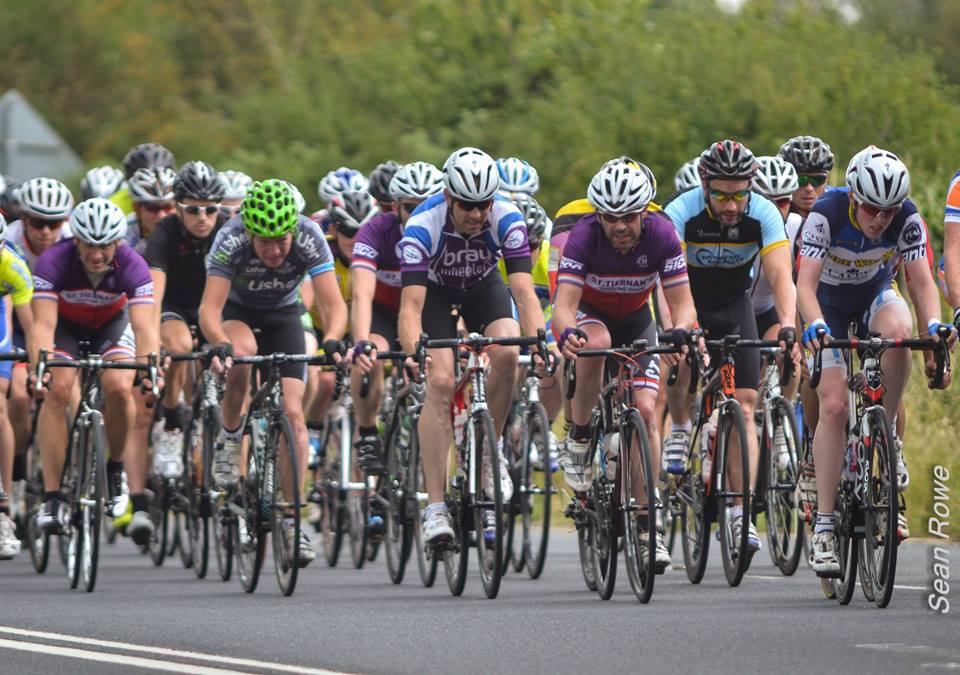How to make your cycle racing debut
YOU’VE done the training, researched the course, set up your bike, packed your kit and now the morning of your first cycle race has arrived, writes John Malone, racing secretary.
This is where it all gets interesting and you’re one missed toilet break from ruining your chance at glory. Here’s your checklist, schedule and all you can expect on your cycle racing debut.
The big day
- Get there in good time
- Sign on when you arrive
- Do a warm up
- Find the start 10 mins before your race
Aim to be at the race HQ at least an hour – sometimes 1.5 hours – before the start. It might seem a lot but with a warm up, getting changed, queuing for the loo and general faffing around, it goes pretty quick.
 First thing you need to do is sign on. Sign on will be well marked, usually, (follow the crowds) and you’ll need your Cycling Ireland licence card, or a print out from the website, as well your entry fee. Entry tends to be around €15. They’ll check your card and have you sign one of the sheets. Ask them about the start; if it’s a rolling start or a standing start, and where these will take place.
First thing you need to do is sign on. Sign on will be well marked, usually, (follow the crowds) and you’ll need your Cycling Ireland licence card, or a print out from the website, as well your entry fee. Entry tends to be around €15. They’ll check your card and have you sign one of the sheets. Ask them about the start; if it’s a rolling start or a standing start, and where these will take place.
Get changed, find your club mates and warm up. Warming up is important as things usually kick off early in the race, so you don’t want to just rock up to the line without having got some work in first. If it’s possible, ride the last few kilometres of the course while getting your heart rate up and working up a sweat.
You’ll be standing around for a while after you warm up, so a gilet or jacket you can stuff in your pocket is great to have. Even if it’s not wet or cold, you’ll be sweating after the warm up so will get cold pretty quick.
Find that starting line. If it’s a rolling start, you’ll often ride out from sign on for a few kilometres to the course and, without much fanfare, you’ll suddenly be racing.
If it’s a standing start, find out where this is. There could be three or more other races for other groups of riders going on, so find out where in the pecking order you’ll be.
If you’re doing an A4-only race, your race will start after the other races. If you’re doing a handicap race, you’ll be starting first and will be hunted down by the other groups.
The race
- Start at the front if possible
- Stay close to the front of the bunch
- Don’t make sudden manoeuvres
- Stay calm
- Fingers on the brakes at all times
- Arm high in the air if you puncture
Races are quite different to the ordered environs of a club ride. There’ll be riders all over the place, the bunch will be constantly changing, with riders moving up and down the peloton.
Staying at the front is easier than getting to the front, so if you can, start the race right at the front, and ideally you want to remain near the front of the bunch. By staying near the front, you’ll have most of the bunch behind you – with more riders behind you and less in front, you are less likely to be caught behind a crash.
The concertina effect of riders accelerating out of corners will also be a factor near the back of the field. As riders speed up out of a turn, gaps will form, and as the bunch makes its way around, the gaps will get bigger. By the time the last rider makes their way around they’ll have a lot more work to do than the first rider did.
Don’t worry at this stage about doing work or getting stuck up there. You won’t be there long at this stage in your cycle racing career. So, stay near the front if you can manage it, but not at the front.
That last note is key: Being at the front as you roll out is ok, but you should not be on the front of the race unless you’ve attacked the bunch or are winning the race. You’ll use up huge amounts of energy by being on the front versus being in the bunch.
Attacking the bunch and getting into a break is a good plan for any race. You need to be near the front of the bunch to either follow someone else’s break or to kick one off yourself. You cannot start a break, or get away from the bunch, while on the front. You will simply drag the bunch with you.
You must be a few rows back and going at full speed when you hit the front or you won’t get away. If you’re on the front working hard you are almost certainly wasting your energy.
Don’t brake suddenly unless you really have to. If you brake suddenly there’s a very high chance someone will run into the back of you and/or someone behind you will crash.
Don’t suddenly dive to the left or right into a gap. Looking behind you to check isn’t often a great plan either as you’ll tend to move off your line and drift around the road. Indicating with hand signals before pulling into a different line up helps a lot.
On climbs, be aware that when you, or someone in front of you, stands up, the bike slows down and moves backwards. If you’re standing on a climb learn how to do it without slowing the bike down and warn people by saying “standing” or similar.
Like in a club ride call out major issues with the road with a call of “left” or “right” depending on where the issue is. Don’t call out every bump though as each one will tend to cause people to brake and move around a bit, which itself is a risk in a big bunch.
 Be aware of what’s going on ahead of you and don’t worry about what’s going on behind you. You’ll be able to see the riders ahead move slightly to the right, for example, indicating a pothole or another unseen obstacle. You probably won’t be able to see the road, so you might end up riding into potholes and the like – be prepared for that.
Be aware of what’s going on ahead of you and don’t worry about what’s going on behind you. You’ll be able to see the riders ahead move slightly to the right, for example, indicating a pothole or another unseen obstacle. You probably won’t be able to see the road, so you might end up riding into potholes and the like – be prepared for that.
Don’t look behind you in the bunch. If you look behind, you will very likely drift off line into someone else. Nothing interesting is behind you anyway, unless it’s the last 100m and you are checking if you have time to sit up and enjoy your solo win. Otherwise, keep looking ahead.
Always keep your fingers on the brakes. Never ride in the bunch with your hands on the top bar (where you can’t reach the brakes) unless you are climbing a steep gradient and going quite slowly in a thinned-out bunch. Usually hoods or drops with fingers on the levers.
If you puncture in the bunch, don’t brake or suddenly slow down. Ideally don’t brake at all. Keep pedalling if you can and raise your hand straight up as high as you can, calling out “left”, “centre” or “right”, depending on where you are on the road. , For example, if you’re on the left-hand gutter, call “left”, indicating to riders behind that you are now an obstruction.
Keep your speed honest, if at all possible, and let riders pass you in a controlled fashion – don’t just throw out the anchors and stop. When you’re sure all riders are past pull in, way off the road.
There will be other races in progress and you need to keep well clear as you fix your puncture. If you’re on tubulars or don’t have any puncture repair gear, stick out a thumb and someone will either give you a lift or a wheel, and you can get back to sign on.
Race tactics and the like are a discussion for a different day, but the number one tip for day one is to hang in there as long as you possibly can in the bunch. Once you lose a bike length or two out the back of a large bunch, your day is probably done.


Got something to say?